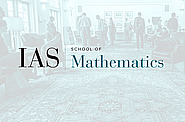Seminars
Oct
21
2014
Oct
20
2014
Oct
14
2014
Computer Science/Discrete Mathematics Seminar II
Sampling-based proof of the quasipolynomial Bogolyubov-Ruzsa theorem and algorithmic applications
10:30am|West Bldg. Lect. Hall
Oct
13
2014
Computer Science/Discrete Mathematics Seminar I
Cool with a Gaussian: an \(O^*(n^3)\) volume algorithm
Santosh Vempala
11:15am|West Bldg. Lect. Hall
Oct
07
2014
Computer Science/Discrete Mathematics Seminar II
Monotone submodular maximization over a matroid
10:30am|S-101
Oct
06
2014
Computer Science/Discrete Mathematics Seminar I
The communication complexity of distributed subgraph detection
Rotem Oshman
11:15am|S-101
Sep
30
2014
Sep
29
2014
Computer Science/Discrete Mathematics Seminar I
Breaking \(e^n\) barrier for deterministic poly-time approximation of the permanent and settling Friedland's conjecture on the Monomer-Dimer Entropy
11:15am|S-101
Sep
23
2014
Sep
22
2014
Computer Science/Discrete Mathematics Seminar I
Colouring graphs with no odd holes
Paul Seymour
11:15am|S-101
